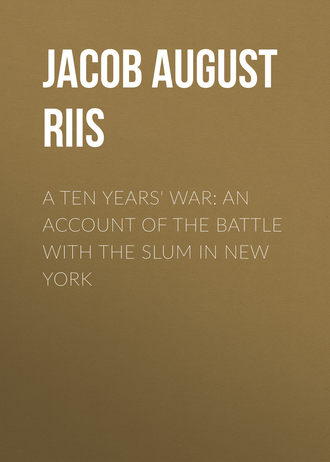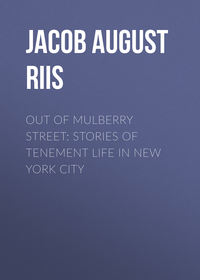 полная версия
полная версияA Ten Years' War: An Account of the Battle with the Slum in New York
A law which is in substance a copy of the English act for destroying slum property was passed in the spring of 1895. It provides for the seizure of buildings that are dangerous to the public health or unfit for human habitation, and their destruction upon proper proof, with compensation to the owner on a sliding scale down to the point of entire unfitness, when he is entitled only to the value of the material in his house. Up to that time, the only way to get rid of such a house had been to declare it a nuisance under the sanitary code; but as the city could not very well pay for the removal of a nuisance, to order it down seemed too much like robbery; so the owner was allowed to keep it. It takes time and a good many lives to grow a sentiment such as this law expressed. The Anglo-Saxon respect for vested rights is strong in us, also. I remember going through a ragged school in London, once, and finding the eyes of the children in the infant class red and sore. Suspecting some contagion, I made inquiries, and was told that a collar factory next door was the cause of the trouble. The fumes from it poisoned the children's eyes.
"And you allow it to stay, and let this thing go on?" I asked, in wonder.
The superintendent shrugged his shoulders. "It is their factory," he said.
I was on the point of saying something that might not have been polite, seeing that I was a guest, when I remembered that, in the newspaper which I carried in my pocket, I had just been reading a plea of some honorable M. P. for a much-needed reform in the system of counsel fees, then being agitated in the House of Commons. The reply of the solicitor general had made me laugh. He was inclined to agree with the honorable member, but still preferred to follow precedent by referring the matter to the Inns of Court. Quite incidentally, he mentioned that the matter had been hanging fire in the House two hundred years. It seemed very English to me then; but when we afterward came to tackle our rear tenements, and in the first batch there was a row which I knew to have been picked out by the sanitary inspector, twenty-five years before, as fit only to be destroyed, I recognized that we were kin, after all.
That was Gotham Court. It was first on the list, and the Mott Street Barracks came next, when, as executive officer of the Good Government Clubs, I helped the Board of Health put the law to the test the following year. The Health Department kept a list of 66 old houses, with a population of 5460 tenants, in which there had been 1313 deaths in a little over five years (1889-94). From among them we picked our lot, and the department drove the tenants out. The owners went to law, one and all; but, to their surprise and dismay, the courts held with the health officers. The moral effect was instant and overwhelming. Rather than keep up the fight, with no rent coming in, the landlords surrendered at discretion. In consideration of this, compensation was allowed them at the rate of about a thousand dollars a house, although they were really entitled only to the value of the old material. The buildings all came under the head of "wholly unfit." Gotham Court, with its sixteen buildings, in which, thirty-five years ago, a health inspector counted 146 cases of sickness, including "all kinds of infectious disease," was bought for $19,750, and Mullen's Court, adjoining, for $7251. They had been under civilized management since, but nothing decent could be made out of them. To show the character of all, let two serve; in each case it is the official record, upon which seizure was made, that is quoted:—
No. 98 Catherine Street: "The floor in the apartments and the wooden steps leading to the second-floor apartment are broken, loose, saturated with filth. The roof and eaves gutters leak, rendering the apartments wet. The two apartments on the first floor consist of one room each, in which the tenants are compelled to cook, eat, and sleep. The back walls are defective; the house wet and damp, and unfit for human habitation. It robs the surrounding houses of light."
"The sunlight never enters" was the constant refrain.
No. 17 Sullivan Street: "Occupied by the lowest whites and negroes, living together. The houses are decayed from cellar to garret, and filthy beyond description,—the filthiest, in fact, we have ever seen. The beams, the floors, the plaster on the walls, where there is any plaster, are rotten and alive with vermin. They are a menace to the public health, and cannot be repaired. Their annual death rate in five years was 41.38."
The sunlight enters where these stood, at all events, and into 58 other yards that once were plague spots. Of 94 rear tenements seized that year, 60 have been torn down, 33 of them voluntarily by the owners; 29 were remodeled and allowed to stand, chiefly as workshops; 5 other houses were standing empty, and yielding no rent, in March, 1899. The worst of them all, the Mott Street Barracks, are yet in the courts; but all the judges and juries in the land have no power to put them back. It is a case of "They can't put you in jail for that"—"Yes, but I am in jail." They are gone, torn down under the referee's decision that they ought to go, before the Appellate Division called a halt. In 1888 I counted 360 tenants in these tenements, front and rear, all Italians, and the infant death rate of the Barracks that year was 325 per 1000. There were forty babies, and one in three of them had to die. The general infant death rate for the whole tenement house population that year was 88.38. In the four years following, during which the population and the death rate of the houses were both reduced with an effort, fifty-one funerals went out of the Barracks. With entire fitness, a cemetery corporation held the mortgage upon the property. The referee allowed it the price of opening one grave, in the settlement, gave one dollar to the lessee and one hundred and ten dollars to the landlord, who refused to collect, and took his case to the Court of Appeals, where it is to be argued this summer. The only interest that attaches to it, since the real question has been decided by the wrecker ahead of time, is the raising of the constitutional point, perchance, and the issue of that is not doubtful. The law has been repeatedly upheld, and in Massachusetts, where similar action has been taken since, the constitutionality of it has in no case been attacked, so far as I know.
I have said before that I do not believe in paying the slum landlord for taking his hand off our throats, when we have got the grip on him in turn. Mr. Roger Foster, who as a member of the Tenement House Committee drew the law, and as counsel for the Health Department fought the landlords successfully in the courts, holds to the opposite view. I am bound to say that instances turned up in which it did seem a hardship to deprive the owners of even such property. I remember especially a tenement in Roosevelt Street, which was the patrimony and whole estate of two children. With the rear house taken away, the income from the front would not be enough to cover the interest on the mortgage. It was one of those things that occasionally make standing upon abstract principle so very uncomfortable. I confess I never had the courage to ask what was done in their case. I know that the tenement went, and I hope—Well, never mind what I hope. It has nothing to do with the case. The house is down, and the main issue decided upon its merits.
In the 94 tenements (counting the front houses in; they cannot be separated from the rear tenements in the death registry) there were in five years 956 deaths, a rate of 62.9 at a time when the general city death rate was 24.63. It was the last and heaviest blow aimed at the abnormal mortality of a city that ought, by reason of many advantages, to be one of the healthiest in the world. With clean streets, pure milk, medical school inspection, antitoxin treatment of deadly diseases, and better sanitary methods generally; with the sunlight let into its slums, and its worst plague spots cleaned out, the death rate of New York came down from 26.32 per 1000 inhabitants in 1887 to 19.53 in 1897. Inasmuch as a round half million was added to its population within the ten years, it requires little figuring to show that the number whose lives were literally saved by reform would people a city of no mean proportions. The extraordinary spell of hot weather, two years ago, brought out the full meaning of this. While many were killed by sunstroke, the population as a whole was shown to have acquired, in better hygienic surroundings, a much greater power of resistance. It yielded slowly to the heat. Where two days had been sufficient, in former years, to send the death rate up, it now took five; and the infant mortality remained low throughout the dreadful trial. Perhaps the substitution of beer for whiskey as a summer drink had something to do with it; but Colonel Waring's broom and unpolitical sanitation had more. Since it spared him so many voters, the politician ought to have been grateful for this; but he was not. Death rates are not as good political arguments as tax rates, we found out. In the midst of it all, a policeman whom I knew went to his Tammany captain to ask if Good Government Clubs were political clubs within the meaning of the law, which prohibits policemen from joining such. The answer he received set me to thinking: "Yes, the meanest, worst kind of political clubs, they are." Yet they had done nothing worse than to save the babies, the captain's with the rest.
The landlord read the signs better. He learned his lesson quickly. All over the city, he made haste to set his house to rights, lest it be seized or brought to the bar in other ways. The Good Government Clubs did not rest content with their first victory. They made war upon the dark hall in the double-decker, and upon the cruller bakery. They opened small parks, exposed the abuses of the civil courts, the "poor man's courts," urged on the building of new schools, compelled the cleaning of the Tombs prison and hastened the demolition of the wicked old pile, and took a hand in evolving a sensible and humane system of dealing with the young vagrants who were going to waste on free soup. The proposition to establish a farm colony for their reclamation was met with the challenge at Albany that "we have had enough reform in New York city," and, as the event proved, for the time being we had really gone as far as we could. But even that was a good long way. Some things had been nailed that could never again be undone; and hand in hand with the effort to destroy had gone another to build up, that promised to set us far enough ahead to appeal at last successfully to the self-interest of the builder, if not to his humanity; or, failing that, to compel him to decency. If that promise has not been kept, the end is not yet. I believe it will be kept.
The movement for reform, in the matter of housing the people, had proceeded upon a clearly outlined plan that apportioned to each of several forces its own share of the work. At a meeting held under the auspices of the Association for Improving the Condition of the Poor, early in the days of the movement, the field had been gone over thoroughly. To the Good Government Clubs fell the task, as already set forth, of compelling the enforcement of the existing tenement house laws. D. O. Mills, the philanthropic banker, declared his purpose to build hotels which should prove that a bed and lodging as good as any could be furnished to the great army of homeless men at a price that would compete with the cheap lodging houses, and yet yield a profit to the owner. On behalf of a number of well-known capitalists, who had been identified with the cause of tenement house reform for years, Robert Fulton Cutting, the president of the Association for Improving the Condition of the Poor, offered to build homes for the working people that should be worthy of the name, on a large scale. A company was formed, and chose for its president Dr. Elgin R. L. Gould, author of the government report on the Housing of the Working People, the standard work on the subject. A million dollars were raised by public subscription, and operations were begun at once.
Two ideas were kept in mind as fundamental: one, that charity that will not pay will not stay; the other, that nothing can be done with the twenty-five-foot lot. It is the primal curse of our housing system, and any effort toward better things must reckon with it first. Nineteen lots on Sixty-Eighth and Sixty-Ninth streets, west of Tenth Avenue, were purchased of Mrs. Alfred Corning Clark, who took one tenth of the capital stock of the City and Suburban Homes Company; and upon these was erected the first block of tenements. This is the neighborhood toward which the population has been setting with ever increasing congestion. Already in 1895 the Twenty-Second Ward contained nearly 200,000 souls. Between Forty-Ninth and Sixty-Second streets, west of Ninth Avenue, there are at least five blocks with more than 3000 tenants in each, and the conditions of the notorious Tenth Ward are certain to be reproduced here, if indeed they are not exceeded. In the Fifteenth Assembly District, some distance below, but on the same line, the first sociological canvass of the Federation of Churches had found the churches, schools, and other educational agencies marshaling a frontage of 756 feet on the street, while the saloon fronts stretched themselves over nearly a mile; so that, said the compiler of these pregnant facts, "saloon social ideals are minting themselves in the minds of the people at the ratio of seven saloon thoughts to one educational thought." It would not have been easy to find a spot better fitted for the experiment of restoring to the home its rights.
The Alfred Corning Clark Buildings, as they were called in recognition of the support of this public-spirited woman, have been occupied a year. When I went through them, the other day, I found all but five of the 373 apartments they contain occupied, and a very large waiting list of applicants for whom there was no room. The doctor alone, of all the tenants, had moved away, disappointed. He had settled on the estate, hoping to build up a practice among so many; but he could not make a living. The plan of the buildings, for which Ernest Flagg, a young and energetic architect, with a very practical interest in the welfare of the Other Half, has the credit, seems to me to realize the ideal of making homes under a common roof. The tenants appeared to take the same view of it. They were a notably contented lot. Their only objection was to the use of the common tubs in the basement laundry,—a sign that, to my mind, was rather favorable than otherwise, though it argued ill for the scheme of public wash houses on the Glasgow plan that has seemed so promising. They were selected tenants as to trustworthiness and desirability on that score, but they were all of the tenement house class. The rents are a little lower than for much poorer quarters in the surrounding tenements. The houses are built around central courts, with light and air in abundance, with fireproof stairs and steam-heated halls. There is not a dark passage anywhere. Within, there is entire privacy for the tenant; the partitions are deadened, so that sound is not transmitted from one apartment to another. Without, the houses have none of the discouraging barrack look. The architecture is distinctly pleasing. The few and simple rules laid down by the management have been readily complied with, as making for the benefit of all. A woman collects the rents, which are paid weekly in advance. The promise that the property will earn the five per cent. to which the company limits its dividends seems certain to be kept. There is nothing in sight to prevent it, everything to warrant the prediction.
The capital stock has since been increased to $2,000,000, and the erection has been begun of a new block of buildings in East Sixty-Fourth Street, within hail of Battle Row, of anciently warlike memory. James E. Ware & Son, the architects who, in the competition of 1879, won the prize for the improved tenements that marked the first departure from the boxlike barracks of old, drew the plans, embodying all the good features of the Clark Buildings with attractions of their own. A suburban colony is being developed by the company, in addition. It is not the least promising feature of its work that a very large proportion of its shareholders are workingmen, who have invested their savings in the enterprise, thus bearing witness to their faith and interest in it. Of the entire number of shareholders at the time of the first annual report, forty-five per cent, held less than ten shares each.
The success of these and previous efforts at the building of model tenements has had the desired effect of encouraging other attempts in the same direction. They represent the best that can be done in fighting the slum within the city. Homewood, the City and Suburban Homes Company's settlement in the country, stands for the way out that must eventually win the fight. That is the track that must be followed, and will be when we have found in rapid transit the key to the solution of our present perplexities. "In the country" hardly describes the site of the colony. It is within the Greater City, on Long Island, hardly an hour's journey by trolley from the City Hall, and only a short walk from the bay. Here the company has built a hundred cottages, and has room for two or three hundred more. Of the hundred houses, seventy-two had been sold when I was there last winter. They are handsome and substantial little houses, the lower story of brick, the upper of timber and stucco, each cottage standing in its own garden. The purchaser pays for the property in monthly payments extending over twenty years. A plan of life insurance, which protects the family and the company alike in the event of the death of the bread-winner, is included in the arrangement. The price of the cottages which so far have found owners has averaged about $3100, and the monthly installment, including the insurance premium, a trifle over $25. It follows that the poorest have not moved to Homewood. Its settlers include men with an income of $1200 or $1500 a year,—policemen, pilots, letter carriers, clerks, and teachers. This is as it should be. They represent the graduating class, as it were, from the city crowds. It is the province of the philanthropic tenement to prepare the next lot for moving up and out. Any attempt to hasten the process by taking a short cut could result only in failure and disappointment. The graduating class is large enough, however, to guarantee that it will not be exhausted by one Homewood. Before the houses were contracted for, without advertising or effort of any kind to make the thing known, more than eight hundred wage earners had asked to have their names put on the books as applicants for suburban homes.
Others had built model tenements and made them pay, but it was left to Mr. D. O. Mills to break ground in the field which Lord Rowton had filled with such signal success in London. The two Mills Houses, in Bleecker and Rivington streets, are as wide a departure as could well be imagined from the conventional type of lodging houses in New York. They are large and beautiful structures, which, for the price of a cot in one of the Bowery barracks, furnish their lodgers with as good a bed in a private room as the boarder in the Waldorf-Astoria enjoys. Indeed, it is said to be the very same in make and quality. There are baths without stint, smoking and writing rooms and games, and a free library; a laundry for those who can pay for having their washing done, and a separate one for such as prefer to do it themselves. There is a restaurant in the basement, in which a regular dinner of good quality is served at fifteen cents. The night's lodging is twenty cents. The dearest Bowery lodging houses charge twenty-five cents. The bedrooms are necessarily small, but they are clean and comfortable, well lighted and heated. The larger house, No. 1, in Bleecker Street, has room for 1554 guests; No. 2, in Rivington Street, for 600. Though this represents more than twelve per cent, of the capacity of all the cheap lodging houses in the city, both have been filled since they were opened, and crowds have often been turned away. The Bowery "hotels" have felt the competition. Their owners deny it, but the fact is apparent in efforts at improvements with which they were not justly chargeable before. Only the lowest, the ten-cent houses, are exempt from this statement. These attract a class of custom for which the Mills Houses do not compete. The latter are intended for the large number of decent mechanics, laborers, and men of small means, hunting for work, who are always afloat in a large city, and who neither seek nor wish charity. The plan and purpose of the builder cannot be better put than in his own words at the opening of the first house.
"No patron of the Mills Hotel," he said, "will receive more than he pays for, unless it be my hearty goodwill and good wishes. It is true that I have devoted thought, labor, and capital to a very earnest effort to help him, but only by enabling him to help himself. In doing the work on so large a scale, and in securing the utmost economies in purchases and in administration, I hope to give him a larger equivalent for his money than has hitherto been possible. He can, without scruple, permit me to offer him this advantage; but he will think better of himself, and will be a more self-reliant, manly man and a better citizen, if he knows that he is honestly paying for what he gets."
Mr. Mills's faith that the business of housing the homeless crowds in decency and comfort could be made to pay just as well as that of housing families in model tenements has been justified. Besides providing a fund sufficient for deterioration and replacement, the two houses have made a clear three per cent. profit on the investment of $1,500,000 which they represent. Beyond this, they have borne, and will bear increasingly, their own hand in settling with the saloon, which had no rival in the cheerlessness of the cheap lodging house or the boarding house back bedroom. Every philanthropic effort to fight it on that ground has drawn renewed courage and hope from Mr. Mills's work and success.
While I am writing, subscriptions are being made to the capital stock of a Woman's Hotel Company, that will endeavor to do for the self-supporting single women of our own city what Mr. Mills has done for the men. It is proposed to erect, at a cost of $800,000, a hotel capable of sheltering over 500 guests, at a price coming within reach of women earning wages as clerks, stenographers, nurses, etc. The number of women whose needs an establishment of the kind would meet is said to exceed 40,000. The Young Women's Christian Association alone receives every year requests enough for quarters to fill a score of such hotels, and can only refer the applicants to boarding houses. Experience in other cities shows that a woman's hotel or club can be managed and made profitable, and there seems to be little doubt that New York will be the next to furnish proof of it. It was the dream of A. T. Stewart, the merchant prince, to do this service for his city, just as he planned Garden City for a home colony for his clerks. It came out differently. The Long Island town became a cathedral city, and the home of wealth and fashion; his woman's hoarding house a great public hotel, far out of the reach of those he sought to benefit. It may be that the success of the banker's philanthropy will yet realize the dream of the merchant before the end of the century that saw his wealth, his great business, his very name, vanish as if they had never been, and even his bones denied, by ghoulish thieves, a rest in the grave. I like to think of it as a kind of justice to his memory, more eloquent than marble and brass in the empty crypt. Mills House No. 1 stands upon the site of Mr. Stewart's old home, where he dreamed his barren dream of benevolence to his kind.
Of all these movements the home is the keynote. That is the cheerful sign that shows light ahead. To the home it comes down in the end,—good government, bad government, and all the rest. As the homes of a community are, so is the community. New York has still the worst housing system in the world. Eight fifteenths of its people live in tenements, not counting the better class of flats, though legally they come under the definition. The blight of the twenty-five-foot lot remains, with the double-decker. But we can now destroy what is not fit to stand; we have done it, and our republic yet survives. The slum landlord would have had us believe that it must perish with his rookeries. We knew that to build decently improved a neighborhood, made the tenants better and happier, and reduced the mortality. Model tenement house building is now proving daily that such houses can be built safer and better every way for less money than the double-decker, by crossing the lot line. The dark hall is not a problem in the tenement built around a central court, for there is no common hall. The plan of the double-decker is shown to be wasteful of space and wall and capital. The model tenement pays, does not deteriorate, and keeps its tenants. After the lapse of ten years, I was the other day in Mr. A. T. White's Riverside Buildings in Brooklyn, which are still the best I know of, and found them, if anything, better houses than the day they were built. The stone steps of the stairways were worn: that was all the evidence of deterioration I saw. These, and Mr. White's other block of buildings on Hicks Street, which was built more than twenty years ago,—occupied, all of them, by distinctly poor tenants,—have paid their owner over five per cent. right along. Practically, every such enterprise has the same story to tell. Dr. Gould found that only six per cent. of all the great model housing operations had failed to pay. All the rest were successful. That was the showing of Europe. It is the same here. Only the twenty-five-foot lot is in the way in New York.











